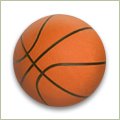 ESPN
ESPNBaby steps.
That's the way someone usually learns how to walk.
You know, take a step forward; fall down; get back up and try again.
For most of us, we accomplish this before our first birthday and never give it a second thought.
For others, life sometimes brings the challenge back around again.
Wayman Tisdale had an incredible career as a basketball player- The first college Freshman to ever be named an All-American, a member of the 1984 gold medal-winning US Olympic team, the 2nd player taken in the NBA Draft.
After 12 years in the NBA, he retired in 1997 to pursue his next career as a jazz musician. But basketball was such an integral part of who he was that he could never separate himself from his past athletic accomplishments. Many of his album titles reflect his love of the game ( Power Forward (1995) , In The Zone (1996), Hang Time (2004) ) and his music often flows like a well-orchestrated run.
Last year, he was diagnosed with cancer and eventually had to have his right leg amputated above the knee. And there he was, lying in a bed with a different body and a new challenge. The way he responded demonstrated both the person he is and the lessons he learned from playing basketball.
As a basketball player, he was already familiar with the need to train his body and took to his rehabilitation with the same intensity he often showed on the court - learning to use an artificial leg 3-4x faster than the average amputee.
In
an ESPN.com article, he discussed how he also used the inner strength and resolve he developed during his basketball career to deal with his disease and his new physical challenges, specifically recalling, "I had some coaches that literally didn't want me to make it, and one in particular was Bobby Knight. At the time, I frowned on that … I look at it today that had I not persevered through a lot of the stuff he put me through, I probably wouldn't be here today. I thank God for that dude because he pushed me."
I'm a big believer that basketball can help young athletes learn lessons and gain experiences that will help them later in life. It's obvious that Mr Tisdale is a talented, creative and motivated individual who became stronger through time on the basketball court. Trying to make the 1984 US Olympic team despite having a coach who was anything but supportive could have been a disaster, but he didn't let a difficult situation get the best of him.
So the next time you have a coach who gets on your nerves, try to look at the situation not as a problem but as an opportunity.
S/he yells at you/picks on you/doesn't give you the playing time you feel you deserve?
Keep your head up and keep working hard through it.
It's a chance for you to grow by overcoming adversity.
One step at a time.














